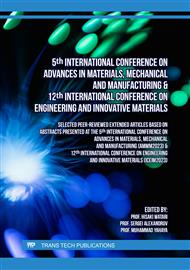p.119
p.125
p.133
p.145
p.153
p.165
p.171
p.181
p.187
Biomechanical Effect of Bone Variables and Implant Position on Femoral Damage Mechanism in Total Hip Arthroplasty
Abstract:
The impact of bone variables, including density, geometry, angle of femoral torsion, and thickness of the femoral cortices, on the formation of bone micro-damage following THA was investigated. Using CT images of avascular necrosis patients, we developed 28 intact femoral bone models with ages ranging from 19 to 87 years to explore the relationship between age and bone density. Among these 28 femur models, 10 models were selected for implantation with the Zweymuller stem, divided into two groups based on the highest and lowest bone mineral density (BMD). After proper stem insertion into the femoral bone canal, finite element analyses with nonlinear damage analysis were performed on the THA models under three boundary conditions: stance, lateral bending, and torsion. Using the Pearson’s correlation coefficient, the study revealed a strong correlation between bone density and fracture load in the 10 THA models, which remained consistent across all three boundary conditions: stance (r = 0.74), lateral bending (r = 0.79), and torsion (r = 0.88). However, a moderate correlation was observed between bone density and the number of solid element failures, which also remained consistent across all boundary conditions: stance (r = -0.40), lateral bending (r = -0.51), and torsion (r = -0.48). It was found that femoral models with a bent shape of the femoral shaft and thin cortices experienced greater bone damage compared to models with normal geometry. Additionally, THA models with retroversion stem placement resulted in higher bone damage compared to models with normal anteversion placement.
Info:
Periodical:
Pages:
187-194
Citation:
Online since:
December 2023
Authors:
Price:
Сopyright:
© 2023 Trans Tech Publications Ltd. All Rights Reserved
Share:
Citation:



